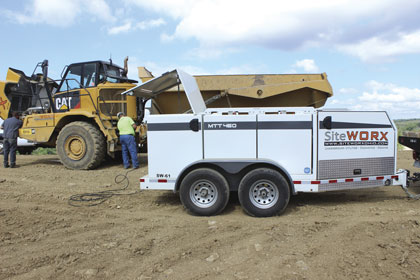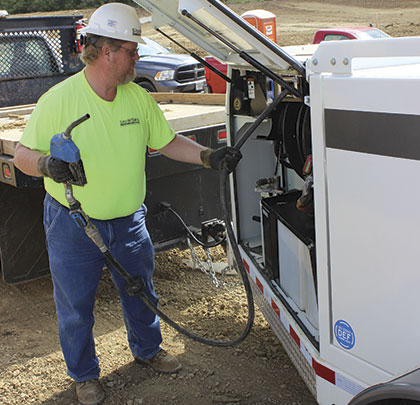SiteWORX—the largest site development company in Cincinnati, Ohio—is currently working on a large residential development project called Greenshire Commons in Cleves, Ohio.
“We’ve already moved about 300,000 cubic yards of dirt on that site, put in several miles of pipe,” says Matt Smith, president and co-owner, SiteWorx. “It’s going to be phased over a 3-year period. We’re currently building the last phase, and that’ll take us into the end of this year.”
FINDING THE RIGHT SOLUTION
Faced with the challenges of an expanding business, SiteWORX was in search of a fueling solution that could help ensure uptime and that fuel was always available, even when only needed in small quantities. After looking at its options, SiteWORX purchased a Multi-Tank Trailer (MTT) and Service & Lube Trailer (SLT) from Thunder Creek Equipment.
“Before we bought the MTT trailer, we [had] our fuel supplier bring out fuel every day and had to have standalone fuel tanks onsite,” says Lou Buehner of SiteWORX. “For service, we either had to pay our equipment supplier to come out and service it, or we had to use our service trucks and send them out and do all the services. But now I can bring out 460 gallons of fuel at a time, 100 gallons of DEF, and take care of most of it on my own.”
“The fact that the MTT doesn’t require a CDL or a HAZMAT is very handy,” says Smith. “We can have any of our crews—most of which do not have a CDL or HAZMAT—hook onto the trailer and take care of their own fueling needs that way. Versus, if it was a different solution, we’ve only got a couple people on staff that have HAZMAT, so we would have to always use them to pull that trailer.”
The trailer also provides an industry-leading DEF handling solution that ensures optimal DEF quality to protect SCR systems. Each trailer can be outfitted with a 100-gallon DEF tank that features Thunder Creek’s closed DEF delivery system, including its proprietary 2-in-1 DEF pump, which ensures that DEF is never exposed to environmental contaminants.
“It’s a self-contained system, so it’s all sealed. You don’t have to worry about cross-contamination,” says Buehner. “The biggest problem with [DEF] is that people go and fill open-end jugs or fill up equipment and they get dirt and dust. With this system, it’s all self-contained, so you don’t have to worry about having cross-contamination. Everything’s adaptable, so there’s nothing to it.”
KEEPING OPERATIONS RUNNING
One recent example of how the fuel trailer helped maintain operations for the contractor revolves around Memorial Day weekend. The company worked part of that weekend, but was unable to get fuel deliveries from its bulk fuel supplier. The trailer helped fill that gap and kept the fleet up and running.
“Memorial Day weekend, we couldn’t get fuel,” says Buehner. “Our fuel supplier was closed. I filled it up four times, took care of all our jobsites, was able to keep running and get another full day of service without having to worry about somebody that couldn’t take care of you. It would be hard to put a dollar amount on it, but you’re talking thousands of dollars of lost revenue and lost production if you can’t get [fuel to your] your jobsite.”

Featured Image: The 2-in-1 closed DEF system prevents DEF contamination and eliminates the hassle of dealing with small jugs of DEF.
Above: SiteWork working on a jobsite outside of Cincinnati, Ohio.
SERVICE ON THE JOBSITE
As it relates to service: With an entire fleet of equipment scattered across the region, it’s significantly easier to bring the service to the jobsite than bring the equipment into the shop. Rather than buying a high horsepower service truck to perform this work, the company purchased a service and lube trailer that achieves many of the same functions, but at a fraction of the cost and without the added maintenance and carrying costs of a large truck.
Thunder Creek’s service and lube trailer features a modular tank design capable of holding 440 gallons of fluid in combinations of 25-, 55- and 110-gallon capacities.
SERVICE TRAILER ADDS UPTIME
“With the service trailer we were kind of at a crossroads where, because of growth, we couldn’t do services in the field out of 5 gallon buckets anymore, we needed something bigger and better,” says Smith. “[The service trailer] gives a mechanic the ability to have all of his stuff with him while he’s out doing this service, he’s got his truck and his tools, and everything that he’s familiar with, he’s not moving his tools that he thinks he’s going to need to a different vehicle, and getting out there and not having what he needs. It just kind of seems like the best of both worlds.”
The investment in the service trailer was about a quarter of the cost of a new service truck that had similar capabilities.
“With a full service truck, it’s got an engine that needs the oil changed, and it’s probably going to be a larger vehicle that has air brakes, so you’ve got DOT certifications that have to be done on it annually. Just multiple services that need to happen on that particular rig that the service trailer does not require nearly as much of.”
“I think the service trailer and the multi-tank trailer both have helped our uptime,” concludes Smith. “The service trailer we can get in the site quick, get a service done maybe while in operator’s eating lunch, just the easy access to everything allows that process to go quicker than if we were trying to use jugs of oil and things like that. Then, with the multi-tank trailer, instead of making those special trips with a 100-gallon tank to help top off fuel, we can stop in and top everything off at one time. It definitely has helped our uptime.” ■
About the Author: Steven Ile is a territory sales representative with Thunder Creek Equipment. For more information about Thunder Creek Equipment, visit www.thundercreek.com.
_________________________________________________________________________
Modern Contractor Solutions – October 2016
Did you enjoy this article?
Subscribe to the FREE Digital Edition of Modern Contractor Solutions magazine.

Fueled and Ready to Work


